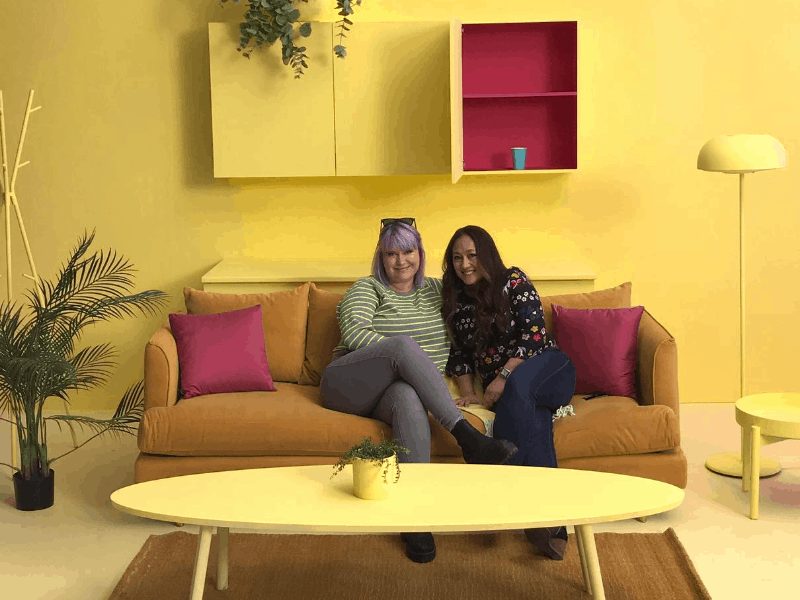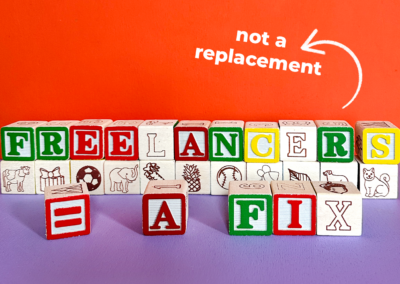I’m typing this on my laptop at 7:55PM, a good two weeks after I initially said I’d write it. But that’s how 2020 goes, isn’t it?
Every normal task takes a lot longer when you’re busy wading through the mental quicksand of compartmentalizing a global pandemic, a long-overdue fight for social justice across America, and your senior dog’s slow decline. She has a chronic cough now—who knew dogs could cough? I half-jokingly wonder for the thousandth time if it’s Covid.
Amanda Acevedo, my very talented art directing partner, wrote part of this article already. I am trying to find a graceful way to merge our words, but she is a much different writer than I am (probably because she is an art director). We make a good team, and We Are Rosie discovered this even before we did, but it’s true. They paired us up on a feminine care brand via an independent agency partner of We Are Rosie back in the Before Times. We spent quite a number of months in 2019 working with their team as creative leads, and got to go to Toronto in February of 2020 and help produce the campaign that sold.
It was awesome – the work and the experience. That’s what this article was initially about: how we did it. We worked together on it remotely before remote work was a mandate. Do you remember back when working remotely was something we did because we wanted to do it that way? Ah, the good old days.
And that’s part of what we’re here to tell you: remote work is amazing. You may not have done it before. You might be experiencing remote work for the very first time in the age of a pandemic. Hundreds of thousands of people are. But don’t worry: this isn’t actually remote work at all. This is working remotely during a global crisis. All that stress you feel? All of the times you internally curse the team member adding 90-minute Zoom meetings to your calendar? All of the pausing work to Google the rising Covid-19 stats in your hometown? None of this is normal remote work. This is hard, and draining, and that is okay. Feeling extra tired and stressed by it is okay. Read those last two sentences out loud to yourself in the mirror if it helps.
Having worked remotely together before Covid, and remotely during Covid, we thought it might be helpful to make this about ways in which you can give yourself a little remote grace and still be a functional colleague in 2020. You should be able to tell that Amanda largely wrote this next part, because it is super helpful and never mentions my dog. But we’re both aligned here. That’s how remote partnerships work. Lots of copying and pasting. Lots of head nods on Zoom calls. Lots of, “Hey, do you care if we go camera off for this one?”
- We’ll start there: go camera off if you need it.
- Don’t feel pressured to have your communications be video calls or feel obligated to have visual contact to seem present— if it can be an email or a phone call, do that. Back-to-back video meetings are exhausting on a repeated basis. Nobody needs that much staring at their own face.
- Make yourself feel less tethered and break out of the stay-at-home monotony. Take your calls outside if possible – on your porch or in your yard. No porch or yard? Go to a park and steal some wifi.
- If I need to tend to any kind of at-home interruption (like my daughter – this is Amanda writing), I’ll turn the camera off and go on mute, rather than leave the video running and interrupt the call or meeting—handling it ‘offline’. This isn’t always an option of course, but don’t feel bad about taking advantage of it when it is one.
- Make remote work as normal as possible. Concentrate on the projects and completion of work rather than daily conversations about the pandemic. You can (of course) vent about pandemic stress to friends and friendly coworkers, but don’t feel obliged to bring it up every time you talk to people if it makes you feel more anxious. There are only so many variants of “Stay safe!” you can use at the end of a Zoom call. “Stay inside!” feels threatening and “Don’t catch a pandemic!” seems off.
- Just because we’re working from home doesn’t mean we need to be working around the clock. We’ve all got different lifestyles, and work/life balance is still important. Be mindful of your team’s needs —be empathetic and understanding. Remote means getting to the desired outcome by embracing flexibility. Take the stigma out of being flexible.
- Talk to each other about what’s working or what’s not. Re-evaluate timing and deadlines to take into consideration the blur of work and home (especially for example, when it comes to people who live with their children). There’s no one way to work remotely. And each client and project is unique. Basically, adapt and realize everyone is figuring things out as they go. Our world has had to slow it down, the reality is we can’t control some things, so worry about what you can control and not about what you can’t.
- Take a break. An actual break, don’t check emails or respond to work notifications on your break or it won’t count. Go outside, watch TV, go for a drive, talk to friends and family. Be a human in the world for a little while, even though the world feels scary right now.
We realize you can get similar advice from similar articles, but if you’re here it means you have some passing interest in advertising (tread carefully), or We Are Rosie (an excellent choice), or working remotely (we miss the 2019 edition).
Or maybe you’re just Anna Kate’s mom. (Hi, Mom.) Whatever brings you here, we hope this helps. Take it to heart that this will pass. Working remotely is so much more enriching and life-fulfilling when you can shut your laptop at the end of the day and go meet a friend at a restaurant for dinner. We’ll get back there. Just keep those masks on, and turn that camera off whenever you feel like it.
Amanda’s Socials: Twitter
Anna’s Socials: Twitter
Editor’s Socials – Bennett D. Bennett: LinkedIn , Twitter



